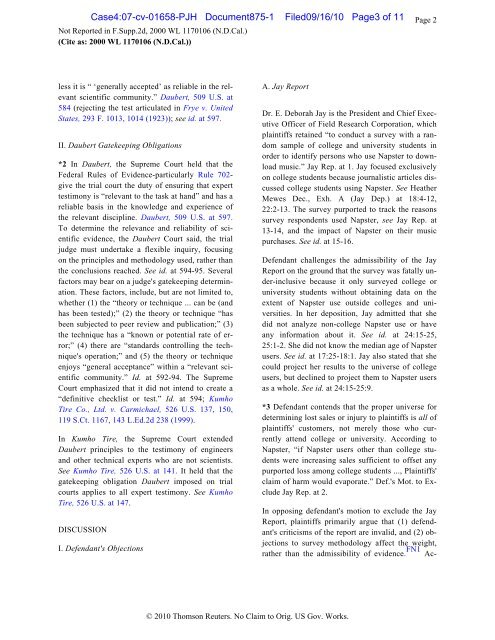exhibit 2 - SAP Lawsuit Portal
exhibit 2 - SAP Lawsuit Portal
exhibit 2 - SAP Lawsuit Portal
You also want an ePaper? Increase the reach of your titles
YUMPU automatically turns print PDFs into web optimized ePapers that Google loves.
less it is “ ‘generally accepted’ as reliable in the relevant<br />
scientific community.” Daubert, 509 U.S. at<br />
584 (rejecting the test articulated in Frye v. United<br />
States, 293 F. 1013, 1014 (1923)); see id. at 597.<br />
II. Daubert Gatekeeping Obligations<br />
*2 In Daubert, the Supreme Court held that the<br />
Federal Rules of Evidence-particularly Rule 702give<br />
the trial court the duty of ensuring that expert<br />
testimony is “relevant to the task at hand” and has a<br />
reliable basis in the knowledge and experience of<br />
the relevant discipline. Daubert, 509 U.S. at 597.<br />
To determine the relevance and reliability of scientific<br />
evidence, the Daubert Court said, the trial<br />
judge must undertake a flexible inquiry, focusing<br />
on the principles and methodology used, rather than<br />
the conclusions reached. See id. at 594-95. Several<br />
factors may bear on a judge's gatekeeping determination.<br />
These factors, include, but are not limited to,<br />
whether (1) the “theory or technique ... can be (and<br />
has been tested);” (2) the theory or technique “has<br />
been subjected to peer review and publication;” (3)<br />
the technique has a “known or potential rate of error;”<br />
(4) there are “standards controlling the technique's<br />
operation;” and (5) the theory or technique<br />
enjoys “general acceptance” within a “relevant scientific<br />
community.” Id. at 592-94. The Supreme<br />
Court emphasized that it did not intend to create a<br />
“definitive checklist or test.” Id. at 594; Kumho<br />
Tire Co., Ltd. v. Carmichael, 526 U.S. 137, 150,<br />
119 S.Ct. 1167, 143 L.Ed.2d 238 (1999).<br />
In Kumho Tire, the Supreme Court extended<br />
Daubert principles to the testimony of engineers<br />
and other technical experts who are not scientists.<br />
See Kumho Tire, 526 U.S. at 141. It held that the<br />
gatekeeping obligation Daubert imposed on trial<br />
courts applies to all expert testimony. See Kumho<br />
Tire, 526 U.S. at 147.<br />
DISCUSSION<br />
Case4:07-cv-01658-PJH Document875-1 Filed09/16/10 Page3 of 11<br />
Not Reported in F.Supp.2d, 2000 WL 1170106 (N.D.Cal.)<br />
(Cite as: 2000 WL 1170106 (N.D.Cal.))<br />
I. Defendant's Objections<br />
A. Jay Report<br />
© 2010 Thomson Reuters. No Claim to Orig. US Gov. Works.<br />
Page 2<br />
Dr. E. Deborah Jay is the President and Chief Executive<br />
Officer of Field Research Corporation, which<br />
plaintiffs retained “to conduct a survey with a random<br />
sample of college and university students in<br />
order to identify persons who use Napster to download<br />
music.” Jay Rep. at 1. Jay focused exclusively<br />
on college students because journalistic articles discussed<br />
college students using Napster. See Heather<br />
Mewes Dec., Exh. A (Jay Dep.) at 18:4-12,<br />
22:2-13. The survey purported to track the reasons<br />
survey respondents used Napster, see Jay Rep. at<br />
13-14, and the impact of Napster on their music<br />
purchases. See id. at 15-16.<br />
Defendant challenges the admissibility of the Jay<br />
Report on the ground that the survey was fatally under-inclusive<br />
because it only surveyed college or<br />
university students without obtaining data on the<br />
extent of Napster use outside colleges and universities.<br />
In her deposition, Jay admitted that she<br />
did not analyze non-college Napster use or have<br />
any information about it. See id. at 24:15-25,<br />
25:1-2. She did not know the median age of Napster<br />
users. See id. at 17:25-18:1. Jay also stated that she<br />
could project her results to the universe of college<br />
users, but declined to project them to Napster users<br />
as a whole. See id. at 24:15-25:9.<br />
*3 Defendant contends that the proper universe for<br />
determining lost sales or injury to plaintiffs is all of<br />
plaintiffs' customers, not merely those who currently<br />
attend college or university. According to<br />
Napster, “if Napster users other than college students<br />
were increasing sales sufficient to offset any<br />
purported loss among college students ..., Plaintiffs'<br />
claim of harm would evaporate.” Def.'s Mot. to Exclude<br />
Jay Rep. at 2.<br />
In opposing defendant's motion to exclude the Jay<br />
Report, plaintiffs primarily argue that (1) defendant's<br />
criticisms of the report are invalid, and (2) objections<br />
to survey methodology affect the weight,<br />
rather than the admissibility of evidence. FN1 Ac-


